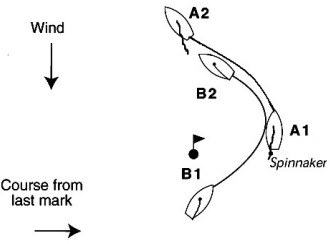The contact was caused by B bearing away. At the time of contact, A’s
spinnaker was not in its normal position, and B’s bow was astern of A’s hull
and all of her equipment that was in normal position. Therefore, there was
no overlap (see the definition Clear Astern and Clear Ahead; Overlap), and
rule 12 applied. It required B to keep clear of A’s hull, equipment and crew,
including her spinnaker.
B broke rule 12 by failing to keep clear, because by sailing towards A’s
spinnaker she created a need for A to take avoiding action (see the definition
Keep Clear). B’s crew had been able to see A’s spinnaker streaming from
the top of her mast for quite some time before the contact, so B’s failure to
keep clear could not be blamed on the fact that A’s spinnaker was not in its
normal position.
Case 77 addresses an incident that appears to be similar but is significantly
different. There, B passed the mark close astern of A with no knowledge
that A would lose control of her spinnaker. B could not have been expected
to foresee that A’s spinnaker would suddenly trail astern by 20 feet (6 m).
In this case, B also broke rule 14 by causing contact she could have avoided.
However, A did not break that rule because, after it became clear that B was
not keeping clear, it was not reasonably possible for her to avoid the contact.
Even if it had been possible, as a right-of-way boat she would have been
exonerated by rule 43.1(c).
B was properly disqualified for breaking rule 12. She also broke rule 14.
Her appeal is dismissed.
|
